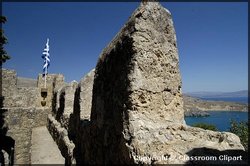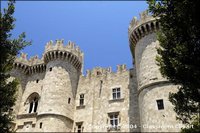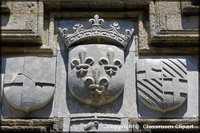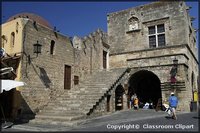Rhodes
|
|
- The Greek island of Rhodes..

Rhodes, is the largest of the Dodecanese islands, and easternmost of the major islands of Greece in the Aegean Sea. It lies approximately 11 miles (17.7km) west of Turkey, situated between the Greek mainland and the island of Cyprus. Its population in 2004 was estimated at 130,000, of which between 60,000 and 70,000 resided permanently in the city of Rhodes, the main commercial and population center. Rhodes is the capital of the District of the Dodecanese and of the Province of Rhodes, which also includes the nearby islands of Symi, Tilos, Halki, and Kastellorizo belong.
Historically, it was known for its Colossus of Rhodes, one of the Seven Wonders of the World. The medieval city is a World Heritage Site.
| Contents |
Geography
The island of Rhodes is shaped like a spearhead, 79.7 km long and 38 km wide with a total area of approximately 1,398 sq km and a coastline of approximately 220 km. The city of Rhodes is located at the far northern end of the island, including the site of the ancient— and modern— commercial harbor. The main air gateway (Diagoras International Airport (http://www.hcaa-eleng.gr/rhod.htm), IATA code: RHO) is located 14 km to the southwest of the city in Paradisi. The road network radiates from the city along the east and west coasts.
The interior is mountainous and sparsely inhabited, covered with pine forests and abundant fauna including the Rhodian deer and peacocks. Features include the so-called Petaludes or Petaloudes Valley, or Valley of the Butterflies, where tiger moths gather in summer; Mount Attavyros, at 3,986 ft (1,215 m) the island's highest point of elevation; and the appropriately named Seven Springs area. While the shores are rocky, arable sandy strips exist where citrus fruits, wine grapes, vegetables, and other crops flourish in the Mediterranean climate.
Outside of the city of Rhodes, the Faliraki resort, Lindos, Archangelos, Afandou, Koskinou, Embona, and Trianta (Ialysos) are significant. The economy of the whole island is geared toward tourism, the island's primary source of income.
History
The island was inhabited in the Neolithic period, although little remains of this culture. In the 16th century BC the Minoans came to Rhodes, and later Greek mythography recalled a Rhodian race they called the Telchines, and associated Rhodes with Danaus; it was sometimes nicknamed Telchinis. In the 15th century the Achaeans invaded. It was, however, in the 11th century that the island started to flourish, with the coming of the Dorians. It was the Dorians who later built the three important cities of Lindos, Ialysos and Kameiros, which together with Kos, Cnidus and Halicarnassus (on the mainland) made up the so-called Dorian Hexapolis.
In Pindar's ode, the island was said to be born of the union of Helios the sun god and the nymph Rhode, and the cities were named for their three sons. The rhoda is a pink hibiscus native to the island.
Invasions by the Persians eventually overran the island, but after their defeat by the forces from Athens in 478 BC, the cities joined the Athenian League. When the Peloponnesian War broke out in 431 BC, Rhodes remained largely neutral although it was still a member of the League. The war lasted until 404 BC, but by this time Rhodes had withdrawn entirely from the conflict and had decided to go her own way.
In 408 BC the cities united to form one territory, and built a new capital on the northern end of the island, the city of Rhodes: its regular plan was superintended by the Athenian architect Hippodamus. However the Peloponnesian War had so weakened the entire Greek culture that it lay open to invasion. In 357 BC the island was conquered by Mausolus of Halicarnassus, then fell to the Persians 340 BC. But their rule was also short and Rhodes became a part of the growing empire of Alexander the Great in 332 BC after he defeated the Persians, to the great relief of the citizens of Rhodes.
With the death of Alexander his generals fought for control. Three of them, Ptolemy, Seleucus, and Antigonus, succeeded in dividing the kingdom among themselves. Rhodes formed strong commercial and cultural ties with the Ptolemies in Alexandria, and together they formed the Rhodo-Egyptian alliance which controlled trade throughout the Aegean in the 3rd century BC. The city developed into a maritime, commercial and cultural center and its coins were in circulation almost everywhere in the Mediterranean. Its famous schools of philosophy and science, literature and rhetoric, shared masters with Alexandria: the Athenian rhetorician Aeschines who formed a school at Rhodes; Apollonius of Rhodes, the astronomers Hipparchus and Geminus, the rhetorician Dionysios Trax. Its school of sculptors developed a rich, dramatic style that can be characterized as "Hellenistic Baroque".
In 305 BC, Antigonus had his son besiege Rhodes in an attempt to break the alliance. After a year they gave up and signed a peace agreement in 304 BC, leaving behind a huge store of military equipment. The Rhodians sold the equipment and used the money to erect a statue of their sun god, Helios, the statue now known as the Colossus of Rhodes.
In 164 BC, Rhodes signed a treaty with Rome, and became a major schooling center for Roman noble families, and was especially noted for its teachers of rhetoric, such as Hermagoras and the author of the Rhetorica ad Herennium. At first the state was an important ally of Rome and enjoyed numerous privileges, but these were later lost in various machinations of Roman politics. Cassius eventually invaded the island and sacked the city.
In the 1st century AD, the Emperor Tiberius spent a brief exile on Rhodes, and Saint Paul brought Christianity to the island. In 297, the long Byzantine period began for Rhodes, when the Roman empire was split and the eastern half became a Greek empire. Although part of Byzantium for the next thousand years, it was nevertheless repeatedly attacked by various forces. It was first occupied by Muslim forces of Muawiyah I in 672. Much later Rhodes was retrieved for the Byzantine Emperor Alexius I Comnenus during the First Crusade.
In 1309 the Byzantine era came to an end when the island was taken by forces of the Knights Hospitaller. Under the rule of the newly named Knights of Rhodes, the city was re-built into a model of the European mediaeval ideal. Many of the city's famous monuments, including the Palace of the Grand Master, were built in this period.
The strong walls which the Knights had built withstood the attacks of the Sultan of Egypt in 1444 and of Mehmed II in 1480. Finally, however, Rhodes fell to the large army of Suleiman the Magnificent in December 1522. The few remaining Knights were permitted to retire to Malta, and the island was a possession of the Ottoman Empire for nearly four centuries.
In 1912, Rhodes was seized from the Turks by the Italians, and in 1947, together with the other islands of the Dodecanese was united with Greece. It thus bypassed many of the events associated with the "exchange of the minorities" between Greece and Turkey.
Throughout much of its history Rhodes had a thriving Jewish Community. From the 1500's on most of this community were Ladino (Judeo-Spanish) speakers. During World War II Nazi Germany occupied the island and deported the Jews. Most ended up dying in various concentration camps. A remnant of the Jewish community survives in Rhodes. The Rhodes Jewish Museum (http://www.rhodesjewishmuseum.org/) maintains a history of the community. Descendants of the "Rhodeslies" now have communities in various parts of the US, Europe and Africa.
Pictures of Rhodes Greece
Photographs of Rhodes, Greece (http://classroomclipart.com/cgi-bin/kids/imageFolio.cgi?direct=Countries_and_Cities/Rhodes)
External references
- Travel to Rhodes (http://www.travel-rhodes.com): Rhodes guide
For a large photo gallery of Rhodes try : Rhodes & Dodecanese Photo Tour (http://www.go12islands.com)




